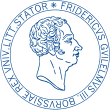Friedrich Gottlieb Welcker
Friedrich Gottlieb Welcker (born November 4, 1784 in Grünberg ; † December 17, 1868 in Bonn ) was a German classical philologist and archaeologist who worked as a professor in Gießen (1809–1816), Göttingen (1816–1819) and Bonn (1819– 1868) worked.
Life
Welcker was one of 17 children of pastor Heinrich Friedrich Welcker and his wife Johannette geb. Strack. His younger brother Carl Theodor Welcker was a famous constitutional lawyer.
Welcker studied classical philology at the University of Giessen from 1801, where he joined the Corps Lahnania in 1801. In 1803 he became a teacher at the pedagogy, a preliminary stage of the university, and in 1804 a private lecturer. In 1806 he traveled to Italy and was a tutor in the family of Wilhelm von Humboldt , whose friend he became and with whom he corresponded. In 1809 he became professor of Greek literature and archeology in Giessen on the recommendation of Humboldt. This is the first indication of the university subject archeology in Germany. In 1812 he founded the (Classical) Philological Seminar, which became the core of high school teacher training.
Welcker campaigned passionately for the fight against the "tyrant" Napoleon and was increasingly popular among students. He was in contrast to many other professors such as the cameraist August Friedrich Wilhelm Crome , who was an admirer of Napoleon. Since the turn of the year 1813/14 there was a political secret society in the Gießen / Mainz / Heidelberg area based on the model of the Masonic lodges (mostly named after the most important members Hoffmann-Snell-Gruner-Bund), which aimed for a unified Germany under Prussian leadership. This included the Welcker brothers and the Giessen student Wilhelm Snell . In 1814 Welcker took part in the Wars of Liberation with over 100 students from Giessen as a volunteer in a hunter battalion .
After his discharge from the Hessian civil service (in September 1816) he went to the University of Göttingen , where he was appointed full professor of Greek literature and archeology on October 3, 1816. In 1817 he was elected a full member of the Royal Society of Sciences . But barely two years later, on February 2, 1819, Welcker moved to the University of Bonn , where he worked as a personal professor of philology and archeology as well as director of the university library and director of the art museum . In 1837/38 he was the rector of the university.
Because of his liberal outlook, Welcker was arrested during the demagogue persecution after the Karlsbad resolutions .
In Bonn, in the later parliamentary and government district, a street was named in Welcker's honor; for decades the press and information office of the federal government was located there. The city of Giessen honored him with the Welckerstrasse named after him.
Listener
On October 27, 1835, Karl Marx and Emanuel Geibel enrolled in his lecture “Greek and Roman doctrine of gods”.
Works
- Sappho freed from prevailing prejudice , Göttingen 1816.
- (Ed.) Journal for the history and interpretation of ancient art , 1818 ( digitized from Heidelberg University Library ).
- The Aeschylean Trilogy , 1824.
- Theognidis Reliquiae , 1826.
- The Epic Cycle or the Homeric Poets , 2 vols., 1835.
- The Greek tragedies arranged with regard to the epic cycle , 3 vol., 1839–1841.
- Greek doctrine of gods , 3 vols., Göttingen, 1857–1862.
literature
- Rector et Senatus Universitatis Fridericiae Guilelmiae Rhenanae: SPD Friderico Theophilo Welckero. Bonn 1868, urn : nbn: de: hbz: 5: 1-28151
- Reinhard Kekulé von Stradonitz : The life of Friedrich Gottlieb Welcker according to his own notes and letters. Teubner, Leipzig 1880.
- August Baumeister : Welcker, Gottlieb . In: Allgemeine Deutsche Biographie (ADB). Volume 41, Duncker & Humblot, Leipzig 1896, pp. 653-660.
- Karl Betz: Friedrich Gottlieb Welcker: A life for science and fatherland. Thraum, Grünberg 1984, ISBN 3-9801036-0-9 .
- William M. Calder III et al. (Ed.): Friedrich Gottlieb Welcker: Work and Effect. Lectures, held at the Welcker conference in the Werner Reimers Foundation in Bad Homburg from 5. – 7. November 1984 (= Hermes . Einzelschriften, H. 49). Steiner-Verlag-Wiesbaden-GmbH, Stuttgart 1986, ISBN 3-515-04420-5 .
- Peter Moraw: A brief history of the University of Giessen from its beginnings to the present. Ferber, Giessen 1990, ISBN 3-927835-00-5 .
- Georgios Fatouros : Welcker, Friedrich Gottlieb. In: Biographisch-Bibliographisches Kirchenlexikon (BBKL). Volume 15, Bautz, Herzberg 1999, ISBN 3-88309-077-8 , Sp. 1459-1463.
- Manfred Schöncke: “A happy year in Bonn”? What we know about Karl Marx's first year at university . In: Contributions to Marx-Engels research. Neue Episode, 1994, pp. 239-255.
- Karl Betz: Scholar and patriot, researcher and freedom fighter: Friedrich Gottlieb Welcker. In: Preussische Allgemeine Zeitung . No. 44, October 31, 2009.
Web links
- Literature by and about Friedrich Gottlieb Welcker in the catalog of the German National Library
- Works by and about Friedrich Gottlieb Welcker in the German Digital Library
- Internet portal Rheinische Geschichte
Individual evidence
- ↑ Kösener corps lists 1910, 52/15.
- ↑ Matthias Recke , Wolfgang Maaß (Ed.): Gießen at second glance - walks through the university town. Brühlscher Verlag, Gießen 2003, ISBN 3-922300-57-X , p. 37.
- ↑ Welckerstraße in the Bonn street cadastre
- ↑ Manfred Schöncke, pp. 240 and 248.
| personal data | |
|---|---|
| SURNAME | Welcker, Friedrich Gottlieb |
| BRIEF DESCRIPTION | German, classical philologist |
| DATE OF BIRTH | November 4, 1784 |
| PLACE OF BIRTH | Grünberg |
| DATE OF DEATH | December 17, 1868 |
| Place of death | Bonn |


